From the Desk of Eagles Outsider Barry Bowe
CUTTING EDGE
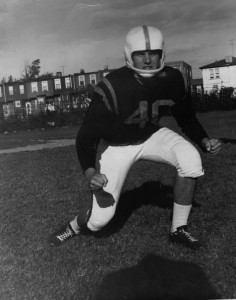 I started playing football during the late 1950s at Clifton Heights in Delaware County. Although we were one of the smallest schools around, we went undefeated during my junior and senior years and we owned the longest winning streak in Pennsylvania.
I started playing football during the late 1950s at Clifton Heights in Delaware County. Although we were one of the smallest schools around, we went undefeated during my junior and senior years and we owned the longest winning streak in Pennsylvania.
More to the point, our coaches taught us how to play football:
- Blocking and tackling
- Kicking
- Running
- Passing and catching
And they also taught us some important nuances of the game:
- Play calling – we called our own plays in the huddle.
- Clock management
- Strategy
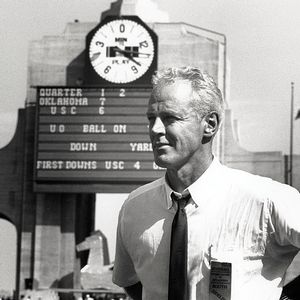 While football gurus would like you to believe that today’s game is cutting edge, it’s pretty much the same as it was back in the 1950s. For instance, from 1953 to 1957 the Oklahoma Sooners won 47 consecutive games – which is still the NCAA record. Head coach Bud Wilkinson believed that if his team ran more plays than his opponents, they had more opportunities to score.
While football gurus would like you to believe that today’s game is cutting edge, it’s pretty much the same as it was back in the 1950s. For instance, from 1953 to 1957 the Oklahoma Sooners won 47 consecutive games – which is still the NCAA record. Head coach Bud Wilkinson believed that if his team ran more plays than his opponents, they had more opportunities to score.
Wilkinson was right, and he was thus running the up-tempo scheme sixty years before Chip Kelly “invented” it.
When I was a little kid, many teams ran out of the single-wing formation. That’s where the tailback took the snap five or six yards behind the center. And then he handed off, passed, or ran.
Today, most teams still run the single-wing as often as they run the T – but they call it the shotgun or the pistol. The quarterback takes the snap five or six yards behind the center. And then he hands off, passes, or runs.
Today – much as it was back then – football is still a game of blocking and tackling – with some running, kicking, passing and catching mixed in.
While self-proclaimed geniuses like Chip Kelly want you to believe they’ve invented a new game, they’re fooling themselves – not me. Oh, there are new rules – many designed to help the offense at the expense of the defense. But the game’s pretty much the same – but with less hitting and new terminology.
However, here’s something different between the game played during the 1950s and the game that’s played today. In fact, it’s a glaring difference that I observe over and over again every week – and it’s driving me crazy.
It happens on third downs – and also in the red zone.
EAGLES – COWBOYS
Let’s take last week’s Eagles matchup with the Cowboys.
In that game, you have to look no further than the Eagles first possession to see what I’m talking about.
Thanks to a running-into-the kicker penalty, the Eagles got a second set of downs instead of going three-and-out – which they do quite often. Which means the Eagles faced two third-down situations on that first possession.
Here’s that entire first sequence.
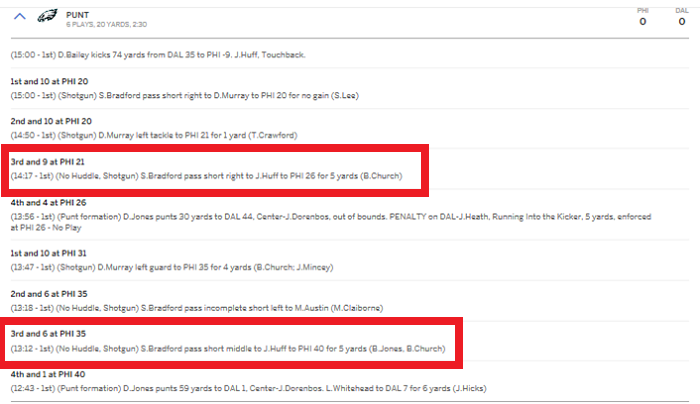
Now let’s zoom in on the two third-down plays.
THIRD AND NINE

In shotgun formation, Sam Bradford connects with Josh Huff for five yards. They needed nine for the first down but got five.
That’s when the Eagles punted – but then kept the ball thanks to the aforementioned running-into-the kicker penalty. But just three plays later, up comes another third down.
THIRD AND SIX
Again in shotgun formation, Sam Bradford connects with Josh Huff for five yards. They needed six for the first down but got five.
Then the Eagles punted again, Dallas got the ball and scored a touchdown to take a 7-0 lead.
On both third downs, passes were thrown short of the yardage needed to pick up the first down.
Huh?
SIXTY YEARS AGO
We never did that.
Here’s how we handled third-down situations sixty years ago.
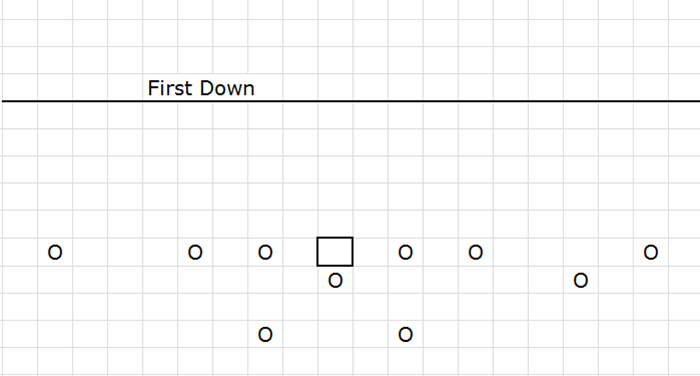
We lined up in a split-T formation. Left end split. Right end flexed with another receiver flanked in between.
Now watch what happens when we snapped the ball
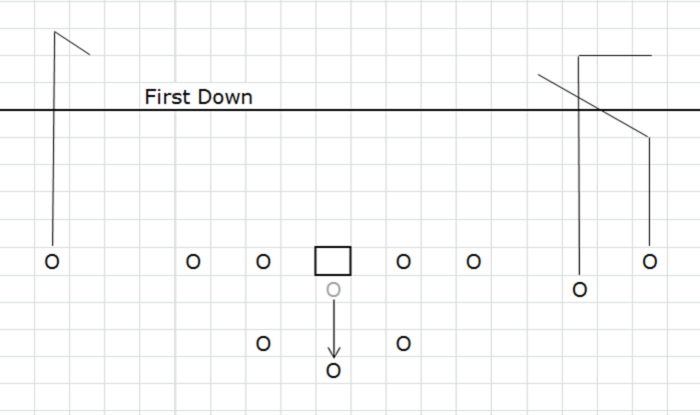
On the snap, the quarterback faked a handoff as he dropped back to pass – freezing the linebackers for an instant while at the same time setting up the potential for play-action somewhere later in the game. (That falls into the category of “strategy.”)
The backs stayed in to block.
Meanwhile the left end ran a button hook while the flanker and right end ran some sort of a criss-crossing pattern. You could always flip-flop the formation, or shift into it, or put a man in motion. There were many ways to disguise the same play. But in this situation I’m keeping it simple.
Now, here’s where our old-fashioned thinking came in handy. All three receivers ran patterns that carried them farther down the field than the yardage needed to get the first down. That way, when they caught the ball, they already had the first down – they didn’t come up short.
Of course there were times when we didn’t get the first down. Maybe the pass was incomplete or the quarterback got sacked – but it was never because we ran a pattern that was too short to get the yardage.
How about that for cutting-edge thinking.
It’s really not difficult. You run farther than you need.
Same thing in the red zone. If it’s third-and-goal, throw the ball into the end zone.
And if it’s third-and-say-seven, throw the ball eight or nine yards down the field – and quit driving me crazy. As Sherlock Holmes would say to his faithful companion:
“Elementary, my dear Watson.”
In addition to being the official Eagles Outsider for BlameMyFather.com, Barry Bowe is also the author of:
- Born to Be Wild
- 1964 – The Year the Phillies Blew the Pennant
- 12 Best Eagles QBs
- Birth of the Birds
- Soon-to-be-published sexy, police procedural Caribbean Queen
- Soon-to-be-published novel Stosh Wadzinski
- Soon-to-be-published novel Polish Widow
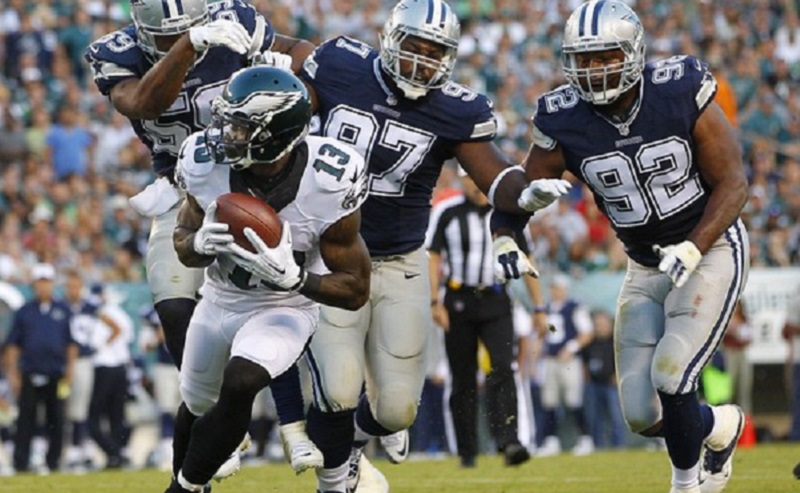

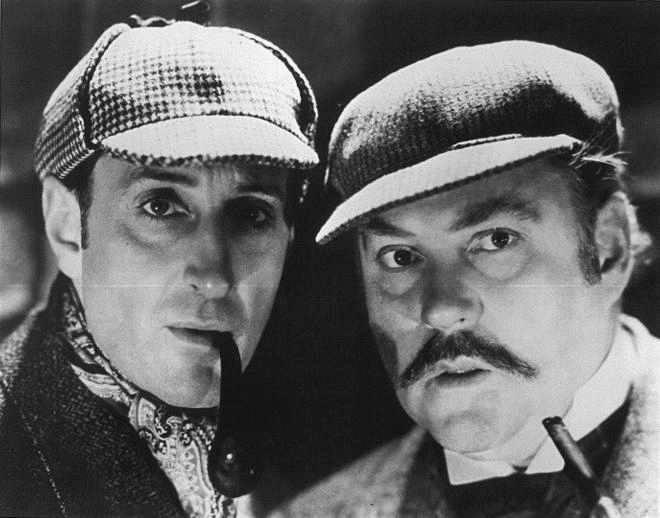

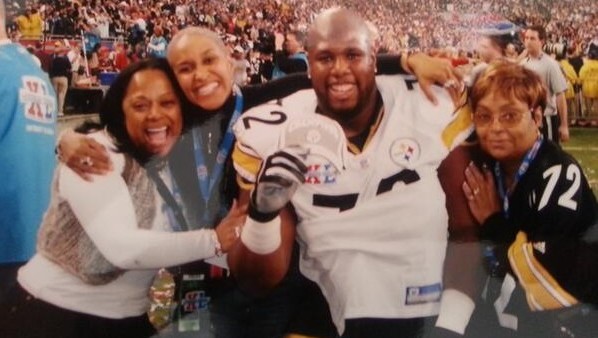



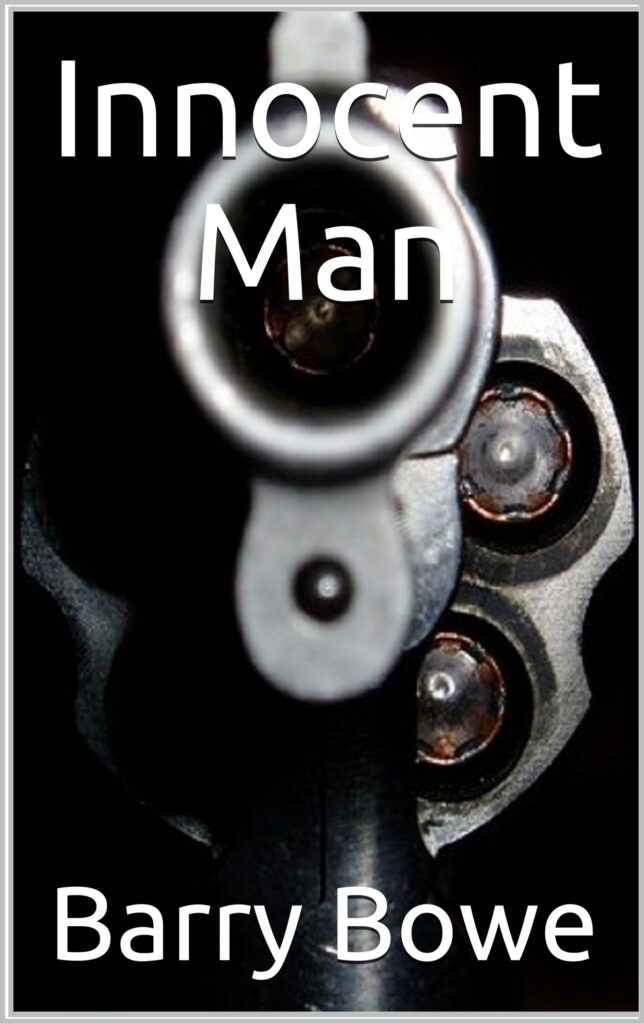

Comments
No Comments